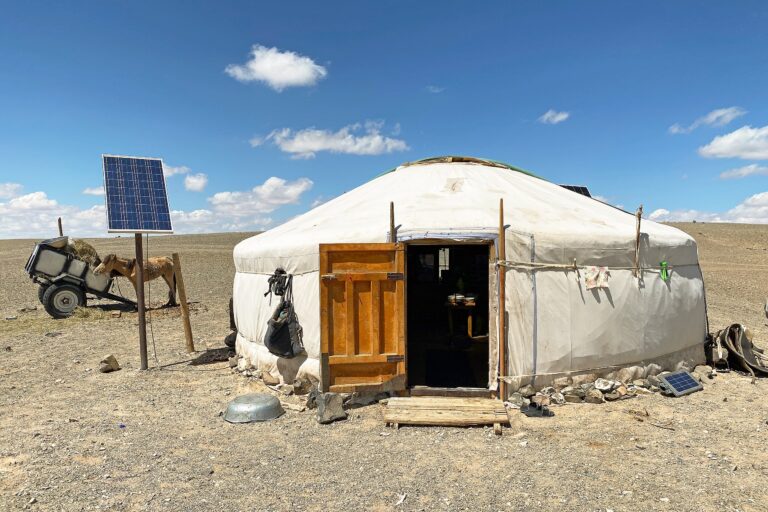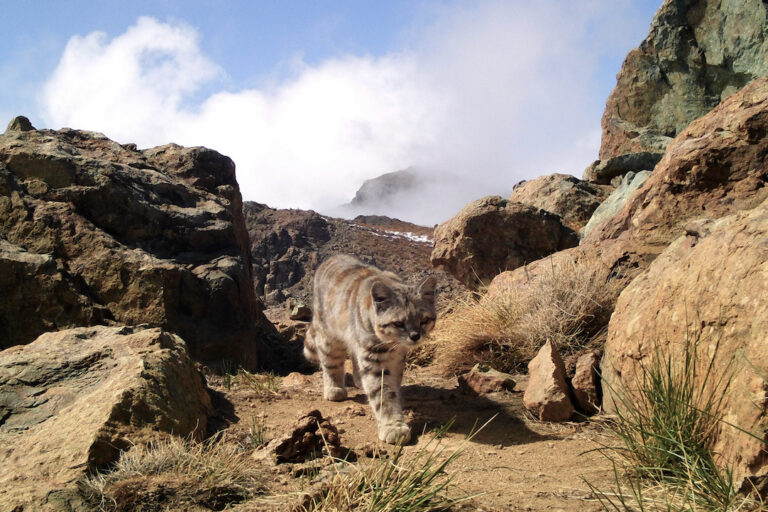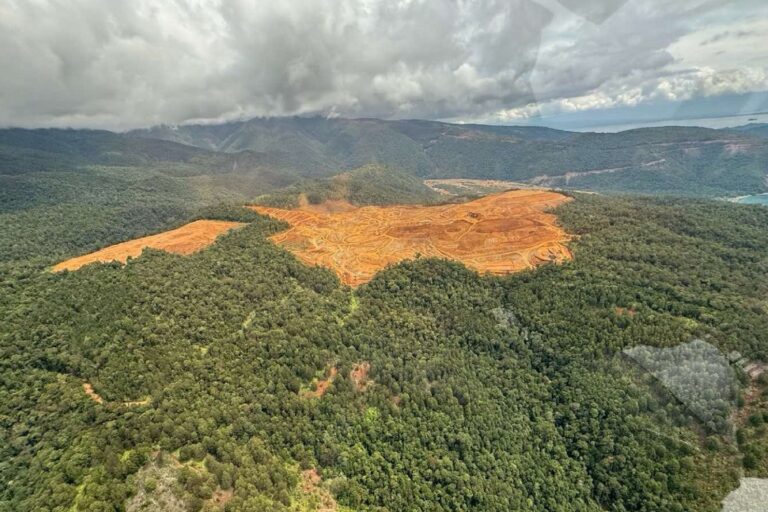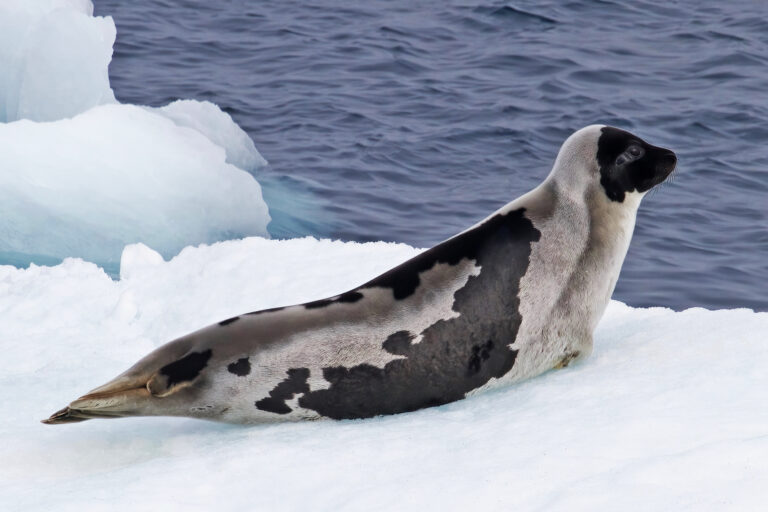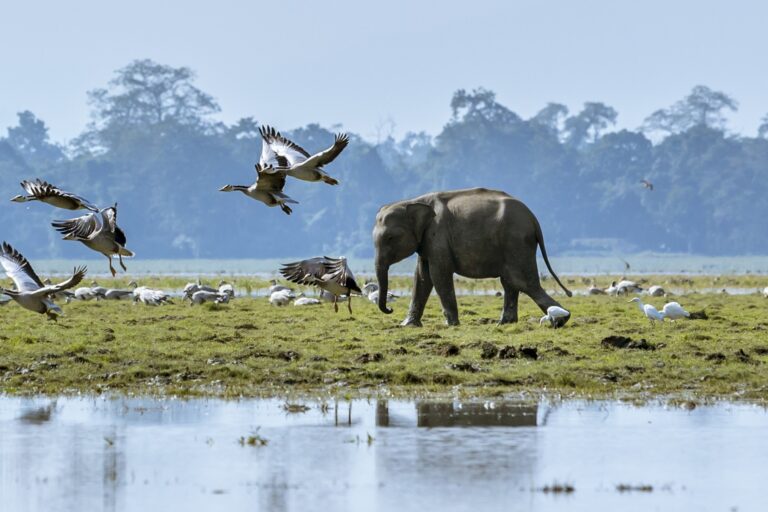- Fernando Trujillo has spent more than 30 years studying the Amazon’s elusive river dolphin, under threat by the fishing trade.
- Twelve years ago, locals started killing river dolphins to attract a lucrative fish to the carcasses, causing the animals to become endangered.
- A new film, A River Below, explores the story of the river dolphin and how it relates to the larger tale of the millions of people who call the Amazon home.
Over thirty years ago, armed with a romantic dream of studying dolphins and a motorboat engine borrowed from a friend, Dr. Fernando Trujillo set off towards the small Amazonian village of Puerto Nariño. The third-year marine biology major soon realized that the Amazon river dolphins (Inia geoffrenis), known locally as botos, were just one piece in the complex aquatic systems making up the “most amazing jungle on the planet.” In Puerto Nariño, Trujillo was struck by indigenous people’s belief that river dolphins are sacred, human-like beings who live in underwater cities.

Today, Trujillo is a renowned marine biologist and the scientific director of the Foundation Omacha, an NGO formed in 1993 that uses education and research to conserve the Amazon river and the species it contains. Omacha’s flagship species is the river dolphin. In 2007, Trujillo won the Whitley Gold Award for his work with Omacha. “Omacha”, which means “pink dolphin” in the Tikuna indigenous language, is also what the indigenous Colombians call Trujillo. To many in the Amazon, he is regarded as a dolphin who became a man.

“All these beliefs around the dolphins from the indigenous – they are disappearing now,” said Trujillo in this interview with Mongabay. He thinks the international community too often forgets that more than 34 million people live in the Amazon, but less than four million of these are indigenous people. The sheer size of the region’s population has led to a reliance on the commercialization and exploitation of wildlife.
In sequence, Trujillo described the “economic forces” that battered the Amazon. Rubber was discovered in the Amazon in the late 19th century, and hundreds of thousands of indigenous people were enslaved and killed. Then, a hunting boom happened throughout the 20th century. A study estimates that between 1904 and 1969, around 23 million animals comprising 20 species of mammals and reptiles were hunted and killed in the western Brazilian Amazon. The reason? The international trade in fur and hides.
In sequence, Trujillo described the “economic forces” that battered the Amazon. Rubber was discovered in the Amazon in the late 19th century, and hundreds of thousands of indigenous people were enslaved and killed. Then, a hunting boom happened throughout the 20th century. A study estimates that between 1904 and 1969, around 23 million animals comprising 20 species of mammals and reptiles were hunted and killed in the western Brazilian Amazon. The reason? The international trade in fur and hides.
“And then it started with the fisheries,” Trujillo said.

The story started twelve years ago, and it involves a fish that is a highly popular delicacy in Colombia – the capaz (Pimelodus grosskopfii). Back then, the capaz was being rapidly overfished (in 2016 the IUCN Red List classified it as as Critically Endangered). The capaz became scarce, so traders began secretly swapping capaz for piracatinga (Calophysus macropterus), a scavenger fish that feeds on rotting flesh. For a long time, consumers were oblivious. Fish is often chopped up and cooked in Brazilian cuisine. Unable to identify the piracatinga by sight, diners would only be able to know what kind of fish they were eating if they were to do a DNA test.
This led to fishermen in Brazil starting to hunt and kill Amazon river dolphins and use their carcasses as bait for piracatinga. Because of their blubber, dead dolphins make an especially good lure for piracatinga. A 2016 study co-authored by Trujillo and published in Biological Conservation shows that Amazon river dolphin numbers are decreasing in several areas, probably due to hunting. Brazil imposed a five-year ban on fishing for piracatinga starting in 2015 – but Trujillo is skeptical that it will succeed, given the sheer size of the now illegal trade.
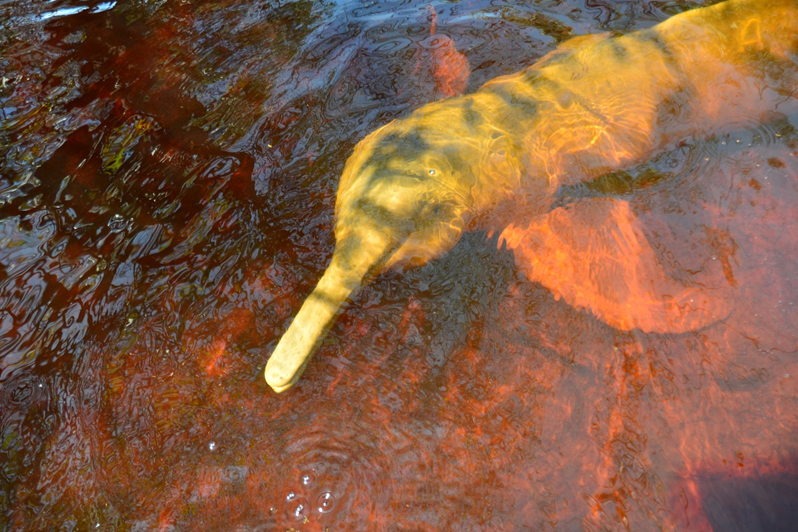
Besides being deliberately hunted, Amazon river dolphins also face conflicts with fishermen over a precious, and increasingly scarce, resource – fish. At the same time, they are threatened by the high mercury content of polluted waters. The harm they suffer becomes more poignant when we learn from Trujillo that river dolphins are – undisputedly – bright and curious beings.
“[I]n the 70s, when people started to use big nets in the Amazon, a lot of dolphins died because they did not realize what the net was, and would get entangled in them. In the 80s, when I started to work, I still looked out for dolphins being entangled, but I started to see dolphins avoiding the nets or jumping above the nets. And in the 90s I realized that the dolphins were going to the nets and taking the fish from them,” Trujillo recalled.
There is still much we do not know about them, according to Trujillo. For example, there is no consensus on how many species of Amazon river dolphins exist. Trujillo is currently working to convince the IUCN – which currently only recognizes one species, Inia geoffrensis, as the sole Amazon river dolphin species – to also recognize Inia boliviensis and Inia araguiaensis as distinct species. Scientists are also unsure how many river dolphins are left in the wild. But this may not be the case for long, because Trujillo and his team at Omacha have surveyed a 27,000-kilometer (16,800-mile) stretch of South American rivers to date, to estimate the size of dolphin populations that live in them. In 2008, the IUCN categorized the Inia geoffrensis as Data Deficient, but this year, it is working with scientists to re-categorize the species – and most agree it should be categorized as either Endangered or Vulnerable.
Trujillo’s group Omacha encourages economic alternatives to fishing to protect dolphin and other river species – for example, sustainable dolphin-watching, craftsmanship, and a dolphin-friendly catfish certification scheme. In response to a group of fishermen who were aggrieved by dolphins, Omacha rallied these fishermen’s wives to form an association and to make fish burgers out of the catfish that had been nibbled by dolphins. For two years, Omacha provided equipment and financial support to the women’s association. As a testament to sustainable economic models, the Amazonian Association of Women Fish Processors now sells roughly 13,000 catfish burgers every month. They use the proceeds as income and for supporting river dolphin conservation.

Around three years ago, film director Marc Grieco and producer Torus Tammer approached Trujillo about a new film. The result was A River Below, which premiered at the Tribeca Film Festival this April and recently bagged the Environmental Award at the Sheffield Doc/Fest.
This is not another save-the-dolphins documentary, said Trujillo. Rather, it cuts to the heart of the entangled relationships between wildlife and various groups of people in the Amazon by following two environmental activists – Trujillo, and Brazilian biologist-cum-reality TV star Richard Rasmussen – as they work to protect the river dolphins. Through their journey, the film examines ethical questions that arise when the media is used to further environmental causes.
Trujillo said being involved with the film gave him a more holistic view of the cause he was fighting for. “It was very difficult for me,” he said, “because all the time [Torus and Marc] wanted to bring out my feelings. And as a scientist, I try to keep my feelings out and I try to be very objective. But finally, I think they won.”
With decades of experience as a researcher and conservationist, Trujillo has been a constant fixture on the frontlines of dolphin conservation in the Amazon. “We are collapsing everything. It’s not just dolphins,” he said. “We are collapsing the fisheries…The river turtles. The manatees. The giant otters. We are destroying the largest forest in the world.”
AN INTERVIEW WITH FERNANDO TRUJILLO
Maxine Chen for Mongabay: You’ve spent the last thirty or so years of your life doing work around the Amazon river dolphin. Will you tell us about your first encounter with the species?
Fernando Trujillo: I was doing marine biology at the [Jorge Tadeo Lozano University], and I wanted to work with dolphins. At the beginning, my lecturers always said, “If you want to work with dolphins, you’d have to go to another country. In Colombia, we don’t have dolphins.” And that was very strange to me. But I had the opportunity to meet Captain Jacques-Yves Cousteau. And I was talking a little bit with him, and he said to me, “Look, I am going to the Amazon, and there are dolphins there, so you should go to the Amazon and study dolphins, because nobody is doing research with these dolphins.” So I started looking for a way to go, and when I was in my third year of university, I finally went in a cargo plane in the Amazon, with an engine that I had [borrowed] from someone.
I arrived in a small town called Puerto Nariño – it’s an indigenous town – and I put the engine in the boat and went to the river. And I was completely in wonder at the presence of the dolphins. Because you are in the middle of the jungle – of the most amazing jungle on the planet – you can see parrots, birds, toucans, and suddenly, you can see a river dolphin! That is very unusual. There are two different species – the pink dolphin and the gray dolphin. And the pink ones are incredible. I was absolutely caught by the beauty of these animals. I should confess I started with a romantic approach – because I wanted to work with dolphins. But I suddenly understood that dolphins were one of the pieces of this complex aquatic system in the Amazon, and the most important things are the humans – the indigenous people.
Dolphins are sacred animals for the indigenous. The indigenous believe that they have underwater cities, and [that] they are like humans, and can become humans. Basically, the indigenous [people] can eat everything in the Amazon – but not dolphins. Eating a dolphin is like eating a human. They are protected and respected. This combination was an amazing thing to watch in the Amazon forests. All these myths and beliefs around the dolphins were important elements for me, and I decided to do something for these animals and for the Amazon.
Mongabay: Have the attitudes of indigenous people towards these animals changed in the past 30 years? What are the attitudes that other groups of people in the Amazon hold towards the dolphins?
https://www.youtube.com/watch?v=Io_O4tE93Ts
A snippet from A River Below, directed by Marc Grieco and featuring Trujillo and Brazilian biologist Richard Rasmussen. Video credit: Sandarba Productions
Fernando Trujillo: Do you know how many people live in the Amazon? There are 34 million people living in the Amazon. And when you ask many people, all of them say maybe one million, two million. There are so many people in the Amazon now – huge cities like Manaus, Brazil have about [two] million people. So basically, everything is changing. And so are the beliefs of the indigenous people.
There have been a lot of economic forces in the Amazon for years. First, hundreds of thousands of indigenous people were enslaved and killed because of rubber. Then there was the international fur trade, and they killed a lot of jaguars and giant otters and other animals for fur. And then it started with the fisheries – the big catfishes. All these beliefs around the dolphins from the indigenous – they are disappearing now. And now, there are more conflicts with dolphins. For example, some fishermen believe that dolphins are serious competition to fisheries, because dolphins used to go to the nets and take fish from the nets. In several places in the Amazon, some fishermen used to shoot dolphins or to poison fish and throw the fish into the water to kill dolphins. So the perception of some people is negative towards dolphins. Same with, for example, caimans or otters.
Humans always blame others for our own actions. I remember one occasion, I was talking with fishermen, and the fishermen were very angry at the dolphins, and they were saying, “We want to kill the dolphins!” And I said, “Okay! If you think that that’s the solution for the fisheries, then let’s go and kill the dolphins!” And the guys went, “Hey, wait, wait, wait. You’re the one who wants to protect the dolphins, and you’re going with us to kill the dolphins?” I said, “Yes! If you’re sure that everything will be perfect once you kill the last dolphin, well, let’s try it!” That’s when the people started to say, “We have more fishermen now, we are collecting a lot of fish – what can we do?” And we started to look for different solutions.
For example, we asked the fishermen to bring the women the next day and we created the [Association of Amazonian Women Fish Processors] to fillet and make burgers out of the catfish that had been bitten by dolphins. And we discovered that there are so few fish of this type that we needed to start using other kinds of fish for the association. So it was a [matter of] perception; only perception.
Everything is changing in the Amazon so quickly.
[In a follow-up e-mail, Trujillo explained that the Association of Amazonian Women Fish Processors was a conservation initiative started by Omacha six years ago. The women involved were relatives of the fishermen who were in conflict with river dolphins. For this initiative, Omacha is supported by the National Learning Service, or Servicio Nacional de Aprendizaje (SENA), a governmental institution that provides support for professional learning and training. Omacha provided the women’s association with equipment and economic support for a few years to produce fish fillets and burgers from the bitten catfish. Today, around 13,000 burgers are sold each month. All proceeds are used either as income for local households or for supporting river dolphin conservation.]
Mongabay: Are river dolphins still being targeted and killed as bait for catfish?
Fernando Trujillo: What happened was the main target of the fisheries was a big catfish. But at the end of the 90s and the beginning of 2000s, the catfish population began to collapse. But the traders wanted to go forward with their business. At that moment, there was a very important fish to the Colombian people called the capaz (Pimelodus grosskopfii). The capaz is from the Magdalena River – this goes straight to the Caribbean. But this fish was disappearing as well, from overfishing. So the traders said, “Okay, let’s change the fish for the other one in the Magdalena.” And the consumers couldn’t realize this. They couldn’t distinguish one fish from the other. So all the capaz that were to be sold in Colombia was actually the piracatinga fish or mota (Calophysus macropterus), coming from the Amazon. And the market started to become so huge that the fishermen moved to Brazil to promote the fishing of the piracatinga.
The way to catch this fish is to use carcasses of dead animals. Dolphins started to be used because dolphins have a lot of blubber. The blubber of the dolphins attracts a lot of piracatinga. They use, in the Brazilian Amazon, the river dolphins, and also the black caiman (Melanosuchus niger). But the black caiman doesn’t have enough blubber. With one black caiman, they can catch 100 kilograms of piracatinga, but with a river dolphin they can catch 200 to 300 kilograms of it.
Everything started twelve years ago. People started killing dolphins in the Brazilian Amazon and there started to be a lot of reports. And at the beginning, the people blamed the Colombian traders [as] the origin of all this new economic activity. But later the Brazilian traders begin to kill dolphins and everything started growing and growing and growing. Some Brazilian researchers started to say that in one year, just in a small area of the Amazon, more than a thousand dolphins are killed to be used as a bait for the scavenger fish piracatinga. There was a lot of international and national reaction. It was only until this Brazilian [news] program, Fantástico, showed the very cruel images of the killing of dolphins that the Brazilian Ministry of the Environment and the Ministry of the Fisheries decide to impose a ban on the fishing of the mota. It started [in 2015] and it’s supposed to last five years.
Mongabay: Has the ban been effective so far?
Fernando Trujillo: At the beginning it seemed like it was. But think about the size of the Amazon. It’s very hard to control and monitor all the borders and the whole area. And it’s more difficult in the sense that the Brazilians eat the fillet of piracatinga. In Colombia, people used to eat the whole fish. If you have the whole fish, you are very sure that you are eating piracatinga. But in Brazil, after the fish is cooked and in pieces, you don’t know what kind of fish you are eating. Only with molecular taxonomy or genetics would you be able to have access to this kind of information. It’s a very big business here. It’s not about bad fishermen, because they are not bad fishermen – the fishermen are very poor people who are only trying to survive, and the traders tell the fisherman what they want for the market. On several occasions, I have really insisted on this. The bad guys are not the fishermen. They are in a position such that they need to do what the traders ask for.
Mongabay: You mentioned the government only reacted to the problem after Fantástico was aired. Do you think that’s an indication of the kind of attitude people generally have towards environmental issues? Or was this reaction specific to this problem in the Amazon?
Fernando Trujillo: Here, probably, the point is governability. The governability in the Amazon is critical because the power is in the hands of these people – the traders, the cattle ranchers, people who have plantations…they have economic power and they have access to the political people. I remember talking to the federal police in Brazil, and they wanted to do an operation to confiscate the fish or to try to get evidence on the killing of dolphins. And sometimes, for example, when they arrive for the freezers, the traders would come with telephones in their hands and say, “it’s for you.” And it would be a superior, telling the police to stop the operation and go back to the office. They have a lot of power.
It was only after Fantástico presented all these images that the public created a lot of pressure and said, “It’s not possible that this is happening in the Amazon.” And that was the way, because the government reacted and said, “OK, OK, OK. Now, we are going to do something.” Because the government knew about this situation for years. For years. It wasn’t new information. For ten or 12 years, the government and the environmental authorities in Brazil knew about this situation.
Mongabay: Did the public know as well?
Fernando Trujillo: Yes! There were a lot of scientists in Brazil and Colombia publishing evidence on this, but no one wanted to do anything because the economic power of the people there. Also, the situation is very complex. In some parts of the film, A River Below, I say – it’s not about dolphins, the film. It’s really about the economy in a region like the Amazon. The people are trying to survive. The whole planet looks to the Amazon as a possibility – as the last reserve of forests on the planet. But these people from other countries have forgotten about the 34 million people already living there. What are they going to do to live? Not only to survive, but to live – for their livelihoods. And it’s a very complex issue. We’re talking about tourists, and fisheries… What will be the activities in the Amazon that can support 34 million people and the more than three million indigenous people living in this area? If you don’t protect these activities, you would always have illegal mining, illegal farming, overfishing, and pollution of rivers, and killing of dolphins…but the government is very weak on these areas, and there are no national or regional policies to develop the Amazon in a sustainable way.
Mongabay: Are you hopeful that things will get better in the region? And on that note, what would you be focusing on moving forward?
Fernando Trujillo: As I mentioned to you, in some ways, when I started to work with dolphins, I started with a romantic approach. But then I discovered there are a lot of complexities in the Amazon, and we started to use dolphins as ambassadors to the aquatic environment in the Amazon Orinoco. Studying dolphins, we are realizing the magnitude of the trade. We are now evaluating the impact of hydroelectric [dams] in Brazil and Bolivia – how we are losing the connectivity of the rivers. The immigration of the fish is now being interrupted, because there are dams and the fish cannot go forward. And the food security of the people there is under threat.
There are lots of things going on in the Amazon. I’m still planning to do my research with dolphins, but at the same time, I want to study – for example – the situation regarding mercury in the Amazon. Omacha and WWF are now producing a map of toxicology in the region. Which rivers contain a lot of mercury? In which rivers do fish contain a lot of mercury? And from which rivers are people getting mercury poisoning? Because we already have this situation. In Colombia, in the Caquetá River for example, national parks had [researched] the effects of mercury on people, and one hundred percent of all indigenous people living near that river have very high levels of mercury. This is very, very worrying. What will happen in ten years, when people start to die from this? Why aren’t governments reacting now that they have the information? It’s very hard.
This year, we are going to start a program putting tags on dolphins to look at their movements along the river and see what’s happening with hydroelectric dams – if the dolphins can move or not, and how their appetites are being reduced. We are also working with local communities to try and provide some sort of economic alternatives, for example, the [Association of Amazonian Women Fish Processors], or as another example, local communities doing dolphin-watching in a sustainable way. We are also encouraging the carving and handicraft artisans with regard to indigenous people in the Amazon. We are trying to look at different options other than the dolphins to protect, a little bit, the aquatic ecosystems. This is the big challenge we want to contribute to.

Photo credit: Sandarba Productions.
Mongabay: What do we know about the behavior of the river dolphins? And what do we still need to learn?
Fernando Trujillo: Two weeks ago, I was in Brazil, and we had a meeting, and we were talking about what we already know about dolphins – and what we need to know in the future. We know they are very intelligent animals. For example, in the 70s, when people started to use big nets in the Amazon, a lot of dolphins died because they did not realize what the net was, and would get entangled in them. In the 80s, when I started to work, I still looked out for dolphins being entangled, but I started to see dolphins avoiding the nets or jumping above the nets. And in the 90s I realized that the dolphins were going to the nets and taking the fish from them. So they are very clever animals.
During the high water season, dolphins are inside the tributaries and lakes, and in the dry season they move to the main river. They take care of their calves in the lakes, and they have a kind of nursery area for this. This is very interesting.
But we still don’t know how many dolphins there are in several rivers. I created a program to estimate the abundance of dolphins in South America. So far, we have surveyed 27,000 kilometers of rivers in Brazil, Bolivia, Venezuela, Colombia, Ecuador and Peru. We have undertaken 27 expeditions. It is the largest expedition with river dolphins in the world. We have trained over 370 people to do abundance estimation of dolphins.
Three weeks ago, I was in Bolivia, training park rangers in national parks on how to monitor dolphins and other aquatic animals in the rivers. This is a very ambitious, long-term program to learn more about the dolphins, and through the dolphins understand a little bit better the complexities of the Amazon and the aquatic ecosystems in the Amazon.
Mongabay: Do we have any clear indications of whether river dolphin populations are going up or declining?
Fernando Trujillo: We published a paper last year in Biological Conservation and it was mentioned by the journal Science as one of the important papers published that year because we showed the population trends of the dolphins in the Amazon. The pink dolphins – the Inia geoffrensis – are decreasing in numbers in several areas – probably the effect of the hunting in different areas. If you think about the reproduction of dolphins, pregnancy lasts about 11 months, and they only have one calf, and they take care of the calf for two years. So a female dolphin can be pregnant every two or three years. So if you’re talking about a thousand dolphins killed a year, just in a small area of Brazil, these numbers give you a feel of what is happening in the Amazon.
We are collapsing everything. It’s not just dolphins. We are collapsing the fisheries. A lot of species in the river are disappearing. The river turtles. The manatees. The giant otters. We are destroying the largest forest in the world.

Mongabay: There has been some debate about the taxonomy of the Amazon river dolphin overall – whether there are three distinct species or subspecies. Where do you come down on this?
Fernando Trujillo: Yes – we are still fighting about this. There are several published papers on genetics in the best journals. We know that there are [Bolivian river dolphins] Inia boliviensis in Bolivia. Two years ago, the [Araguaian river dolphin] Inia araguaiaensis was discovered in the Tocantins River. And we have [the Amazon river dolphin] Inia geoffrensis in the main Amazon Orinoco.
We have started to work with the IUCN to do an assessment for dolphins, because for some reason I don’t understand, in 2008, the Inia geoffrensis was reclassified as Data Deficient. But the good news is that in two months’ time, they are going to have a new assessment, and most people agree that this species has to be in the Endangered or Vulnerable category, with all the evidence of all the things that are happening in the Amazon.
[In a follow-up with Trujillo, Mongabay learned that the Omacha Foundation is also working with the IUCN to validate the two new species and hope to have assessments on them next year.]
Mongabay: Will you tell us how you got involved with A River Below?
Fernando Trujillo: A little more than three years ago, [producer] Torus Tammer contacted me and said he wanted to produce a film about river dolphins. And I thought, “Okay – another film about river dolphins. It’s fine.” But at that moment, Torus said to me, “No, no – it’s not a natural history film about dolphins. I want to use the dolphins to present a deeper story going on in the Amazon.” And it was very difficult for me, because all the time Torus and [director] Marc [Grieco] wanted to bring out my feelings. And as a scientist, I try to keep my feelings out and I try to be very objective. But finally, I think they won. They got my feelings out on the film, and I was just trying to express my feelings and my most internal self – about what’s happening with dolphins and with the Amazon.
Mongabay: How will people be able to see it?
Fernando Trujillo: Torus and Marc are moving around in festivals presenting the movie. I know there’s been some interest from online film distribution companies to buy the film and make it massive. I don’t know when it’ll be made available – but I think people really want to watch the film. For example, at this moment in Brazil, there’s a huge controversy about the film. There are lots of newspapers and magazines publishing stories about the killing of the dolphins, whether Grieco created fake [elements] around the situation or not. But everything – what is going on in the Amazon around the dolphins – is on the film. There is none of the producer and the director on the film. The sentences are from the mouths of Richard [Rasmussen] and from me.
Mongabay: How did working on the film change your work towards river dolphins?
Fernando Trujillo: This film was different for me. I was doing films for National Geographic, Discovery, BBC – more regarding scientific knowledge about the dolphins. But A River Below is more about the ethics of conservation, and the complexities around conservation in the Amazon – the internal and moral conflicts between people there. So it was a different experience for me. It’s changed my point of view and made me think more in a holistic way.

Citations
- Williams, R., Moore, J., Gomez-Salazar, C. Trujillo, F. & L. Burt. 2016. Searching for trends in river dolphin abundance: Designing surveys for looming threats, and evidence for opposing trends of two species in the Colombian Amazon. Biological Conservation 195 (2016) 136–145
- Neira, I. B. (n.d.). Conservation crusader. Retrieved July 10, 2017, from http://www.omacha.org/noticias/190-conservation-crusader
- Antunes, A. P., Fewster, R. M., Venticinque, E. M., Peres, C. A., Levi, T., Rohe, F., & Shepard, G. H. (2016). Empty forest or empty rivers? A century of commercial hunting in Amazonia. Science Advances, 2(10). doi:10.1126/sciadv.1600936







